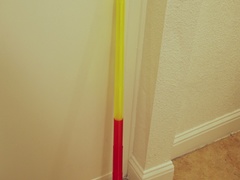
This is a configurable OpenSCAD program that generates a set of collapsible cylinders that can be printed using vase mode. Also included is a simple “end cap” generator for making a simple prop staff similar to a “jo” or “bo” staff. The end cap is meant to be press fit, so that it can be removed if any of the cylinders break and need to be replaced.
Due to tight tolerances this will require a printer and filament that is consistent enough to print in vase mode without any artifacts or defects. If there are defects, it will likely be a problem when the cylinders extend or collapse.
In the program, each cylinder is generated from an iteration number, from 0 to N, with 0 being the innermost, and N being the outermost. For bottom horizontal shells, cylinder 0 zero should be printed with around 4-8, and the rest of the cylinders with 0. The “end cap” piece should also be printed with 4-8 bottom horizontal shells. Another important parameter to set is the extrusion width. Here, 0.85mm is a good starting point even if you are using a 0.4mm nozzle. Also make sure your extrusion multiplier is set accurately, 1.0 is a good starting point for this.
In practice, it will likely take some tuning to get this program working on a specific setup, I did this on my Prusa Mk3s with 3d solutech PETG filament, printing at 30mm/sec (the provided .STL files are for this setup). In practice, I have found that once you get cylinders 0 and 1 mating well, the rest will also.
When fine-tuning the program, there are two values to pay attention to, the adder (a) and multiplier (m). The adder determines the difference in diameter between the top and the bottom of the cylinder, it should be set as small as possible but not less than the extrusion width (0.9 is a good starting point). The multiplier determines how much the diameter of the cylinder grows with each iteration. If the cylinders don’t extend enough, this number needs to be increased; if the cylinders extend too far and slip out of each other, this number needs to be decreased. It may take a few attempts, because 0.1mm of movement here can make a big difference.
This article was first featured at https://www.thingiverse.com/thing:4331530 on May 9, 2020 at 12:52AM by AccessTime






More Stories
Can this possibly be true? “Metal 3D printing is now possible on any 3D printer…with the right settings and a few minor upgrades like a hardened steel nozzle…” – July 2 2023 at 04:59PM
New NASA Funding Ignites 25 3D Printing Projects in Space Exploration – June 18 2023 at 04:34PM
Nvidia AI produces 3D models from 2D videos 3D printing applications forthcoming? – June 15 2023 at 02:55AM